Search results for: 'bronzezeit'
-
 Small Egyptian Kohl vessel
Small Egyptian Kohl vesselThe stone pot was used for Kohl, the eye cosmetic of the ancient Egyptians. Vessel with well preserved body and missing rim. From the 2nd Millenium BC.
Price: on request Small Egyptian Kohl vessel
Small Egyptian Kohl vesselThe stone pot was used for Kohl, the eye cosmetic of the ancient Egyptians. Vessel with well preserved body and missing rim. From the 2nd Millenium BC.
Price: on request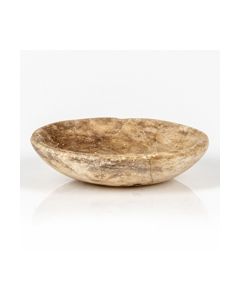 Shallow bowl from Egypt
Shallow bowl from EgyptMade of nicely banded Egyptian alabaster. High quality bowl with a fine polish. Early Dynastic to Old Kingdom.
Price: on request Egyptian Kohl vessel
Egyptian Kohl vesselThe massive stone cosmetic pot was used for Kohl, the eye cosmetic of the ancient Egyptians. From the time between Middle Kingdom and New Kingdom.
€1,800 Kohl vessel from the New Kingdom
Kohl vessel from the New KingdomA fantastic goblet shaped vessel from the 18th dynasty of ancient Egypt. Made of finely polished Egyptian alabaster.
€1,950 Egyptian Kohl vessel
Egyptian Kohl vesselThe small stone container was used for Kohl, the eye cosmetic of the ancient Egyptians. Black remains of the substance are still preserved on the inside. From the time between Middle Kingdom and New Kingdom.
€1,200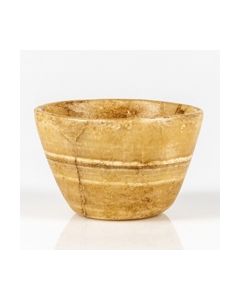 Egyptian stone bowl
Egyptian stone bowlThis wonderful bowl of banded stone was probably used for ritual purposes. From the Early Dynastic Period or Old Kingdom of ancient Egypt.
Price: on request Egyptian Kohl vessel
Egyptian Kohl vesselThe small stone pot of nicely polished granite was used for Kohl, the eye cosmetic of the ancient Egyptians. From the time between Middle Kingdom and New Kingdom.
Price: on request Conical Old Kingdom stone vessel
Conical Old Kingdom stone vesselThe elegant stone vase is made of wonderful banded alabaster. 5th to 6th dynasty, Old Kingdom.
€1,800 Egyptian scarab as a protective amulet
Egyptian scarab as a protective amuletAmulet seal in the shape of a scarab with schematic top side and pseudo hieroglyphs at the underside. Second Intermediate Period of ancient Egypt.
Price: on request Egyptian scarab
Egyptian scarabAmulet seal in the shape of a scarab with schematic top side and braided tape on the underside. Second Intermediate Period of ancient Egypt.
Price: on request Egyptian cowroid
Egyptian cowroidAmulet seal with pseudo hieroglyphs at the underside. Second Intermediate Period of ancient Egypt.
Price: on request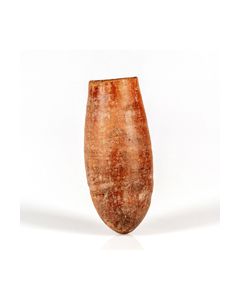 Egyptian predynastic redware jar
Egyptian predynastic redware jarSimple pottery vessel of timeless elegance. From the Naqada I period, 4th Millenium BC.
Price: on request Egyptian scarab with spiral design
Egyptian scarab with spiral designAmulet seal in the shape of a scarab with schematic top side. Second Intermediate Period of ancient Egypt.
Price: on request Egyptian cowroid with protective function
Egyptian cowroid with protective functionAmulet seal with pseudo hieroglyphs at the underside that should give protection or good luck to the owner according to ancient Egyptian beliefs. Second Intermediate Period of ancient Egypt.
Price: on request Egyptian hippopotamus amulet
Egyptian hippopotamus amuletMade in the style of a scarab but with a hippopotamus on the upper side. It was a protective amulet during the 18th or 19th dynasty of Ancient Egypt. It might have protected a pregnant woman. The amulet comes from the famous Matouk collection and is published in his 1971 book.
Price: on request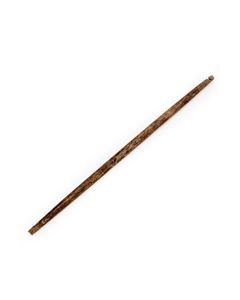 Egyptian spindle shaft made of wood
Egyptian spindle shaft made of woodExceptionally rare main piece of a hand spindle. A find from Thebes in Upper Egypt. From the reign of pharao Senusret II, around 1840 BC.
Price: on request Egyptian cowroid
Egyptian cowroidAmulet seal with pseudo hieroglyphs at the underside. Second Intermediate Period of ancient Egypt.
Price: on request Egyptian cowroid with knot design
Egyptian cowroid with knot designAmulet seal with interesting design at the underside that might represent the unity of Egypt. Second Intermediate Period of ancient Egypt.
Price: on request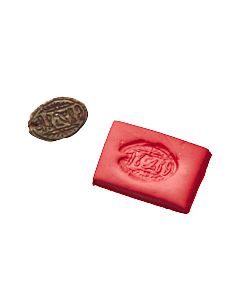 Egyptian cowroid with nice decoration
Egyptian cowroid with nice decorationAmulet seal with pseudo hieroglyphs at the underside that should give protection or good fortune to the owner according to ancient Egyptian beliefs. New Kingdom of ancient Egypt.
Price: on request Egyptian funerary cone of Amunemopet
Egyptian funerary cone of AmunemopetConoid clay nail from the tomb of crown prince Amunemopet. From Thebes during the 18th dynasty. New Kingdom of ancient Egypt.
Price: on request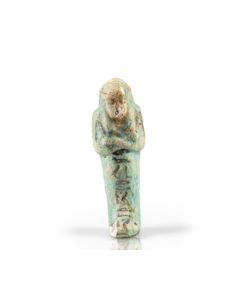 Ushabti for Bu-iri-eri-Renenutet
Ushabti for Bu-iri-eri-RenenutetEgyptian funerary figurine from the Third Intermediate Period. The owner's name is rarely attested and could hint to an origin in the Faiyum Oasis.
Price: on request Clay ushabti
Clay ushabtiTall Egyptian funerary statuette from the New Kingdom. From the collection of the archaeologist and artist Erich Charlier.
Price: on request Großes Skarabäussiegel aus der Zeit des Amenophis III.
Großes Skarabäussiegel aus der Zeit des Amenophis III.14. Jh. v. Chr. Heute noch erhaltene Überreste der Bautätigkeit Amenophis III. sind die Memnonkolosse, sowie der Hauptteil des Luxor-Tempels.
Price: on request Skarabäussiegel mit abstaktem Stempelmotiv
Skarabäussiegel mit abstaktem StempelmotivDie Stempelfläche trägt ein dekoratives Muster mit ästhetischer oder magischer Funktion. Sehr schöner und anschaulicher Skarabäus, in etwa aus der Zweiten Zwischenzeit des Alten Ägyptens. 2000 bis 1300 v. Chr.
Price: on request Ägyptisches Skarabäusamulett aus der 18. Dynastie
Ägyptisches Skarabäusamulett aus der 18. DynastieÄgyptisches Stempelsiegel-Amulett in der stilisierten Form eines Skarabäuskäfers. Die Stempelfläche trägt Hieroglyphen. Das Amulett datiert in die 18. Dynastie des Alten Ägyptens.
Price: on request Skarabäusamulett aus der Hyksoszeit
Skarabäusamulett aus der HyksoszeitÄgyptisches Skarabäusamulett mit typischen Symbolen für die Herrschaftszeit der Hyksos. Aus der Zeit der Fremdherrschaft, ca. 1650 bis 1550 v. Chr.
Price: on request Skaraboides Stempelsiegel
Skaraboides StempelsiegelÄgyptisches Stempelsiegel-Amulett in der stark stilisierten Form eines Skarabäuskäfers. Die Stempelfläche trägt eine symbolische Verzierung. 1. Jt. v. Chr.
Price: on request Ägyptisches Skarabäusamulett
Ägyptisches SkarabäusamulettSkarabäussiegel aus dem 2. Jt. v. Chr. mit ansprechender türkisfarbener Fayenceoberfläche. Die Stempelfläche trägt eine hieroglyphische Inschrift.
Price: on request Fayenceziegel vom Typ der Djoser-Pyramide
Fayenceziegel vom Typ der Djoser-PyramideÄgyptischer Ziegel aus dem Alten Reich, 2. bis 3. Dynastie, intensiv-türkisfarbene Fayence. Ziegelform bekannt aus der berühmten Stufenpyramide von Djoser.
Price: on request Ägyptischer Skarabäus mit Knotenmuster
Ägyptischer Skarabäus mit Knotenmuster12. bis 18. Dynastie des Alten Ägypten, ca. 2000 v. Chr. bis 1300 v. Chr. Die Stempelfläche trägt ein Knotenmuster mit ästhetischer oder mutmaßlich magischer Funktion.
Price: on request Ägyptisches Herzamulett
Ägyptisches Herzamulettca. 946 v. Chr. bis 30 v. Chr. Museale Erhaltung, schöne Patina. Schönes Belegstück eines Herzamuletts.
Price: on request 32 seltene ägyptische Scheibenperlen aus Straußenei-Schalen
32 seltene ägyptische Scheibenperlen aus Straußenei-SchalenGruppe vorantiker Scheibenperlen. Prädynastische Zeit. Durchmesser um 13 mm. Exzellenter Zustand.
Price: on request Skarabäussiegel aus der Hyksos-Zeit
Skarabäussiegel aus der Hyksos-ZeitStempelfläche trägt Muster mit ästhetischer oder mutmaßlich magischer Funktion. Motiv typisch für Herrschaftszeit der Hyksos. 15. bis 16. Dynastie des Alten Ägypten.
Price: on request Skarabäus aus der Zeit der Hyksos
Skarabäus aus der Zeit der HyksosStempelfläche trägt springende Gazelle und Uräusschlangen als Motiv. 15. bis 16. Dynastie des Alten Ägypten, Zeit der Hyksos-Fremdherrschaft.
Price: on request Ägyptisches Skarabäussiegel mit Nil-Krokodil
Ägyptisches Skarabäussiegel mit Nil-KrokodilAuf Stempel Frau vor Nil-Krokodil. Anbetung des Krokodilgotts Sobek. Zweite Zwischenzeit, 13. bis 17. Dynastie des Alten Ägypten.
Price: on request

